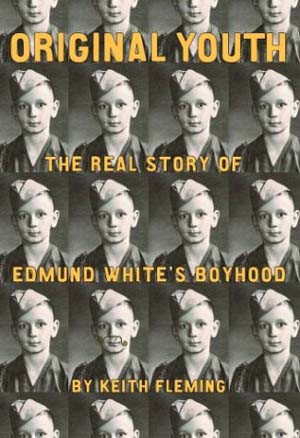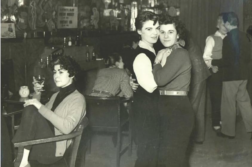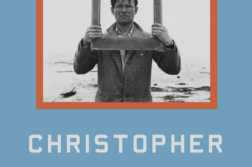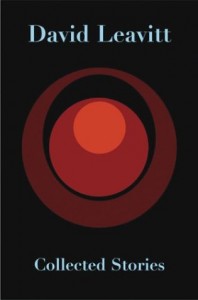 Collected Stories
Collected Stories
by David Leavitt
Bloomsbury. 525 pages, $24.95 (paper)
This volume brings together Leavitt’s short fiction from three earlier collections: Family Dancing (1983), A Place I’ve Never Been (1990), and The Marble Quilt (2001). In his early twenties, Leavitt made a big splash when his short story “Territory” was published in The New Yorker in 1982—arguably the first gay-themed fiction to appear there—an event that he recounts with admirable humility. In this and other stories, Leavitt proves himself a master at putting the reader inside the heads of his characters. In “Family Dancing,” the title story of his first collection, Leavitt weaves together the stories of a family whose members have broken away from each other, who mourn this loss but are unable to find their way back together. Gay themes dominate Leavitt’s fiction, but gay characters aren’t always the voice at center stage. In “Family Dancing,” for example, the gay characters hover at the periphery, eclipsed by the sadly bewildered mother. In “A Place I’ve Never Been,” the title story of Leavitt’s second collection, a young woman who’s the longtime friend of a young gay man finds herself confronting both the meaning of their friendship and the vacancies of her own love life. Leavitt has also proven his talent at historical fiction, notably in his 1993 novel While England Sleeps, set in 1930’s Europe, which embroiled the writer in a lawsuit brought by Stephen Spender. His most recent story collection, The Marble Quilt, offered more examples. In “Crossing St. Gothard,” for example, he describes the sexual anxieties of a young tutor as he escorts two of his charges and their mother on a European rail trip in the early 1900’s. In “Heaped Earth” he describes the tortured, closeted existence of gay actors in 1960’s Hollywood. In “The Infection Scene” he alternates between two timelines, one dealing with the story of Oscar Wilde and his lover Lord Alfred Douglas, the other depicting two young men in 1990’s San Francisco.
Jim Nawrocki
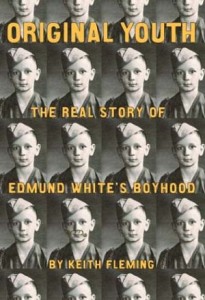 Original Youth
Original Youth
by Keith Fleming
Green Candy Press. 224 pages. $19.95
For those familiar with Edmund White’s many gay novels, and for those who’ve wondered just how autobiographical they really are, Keith Fleming’s Original Youth is sure to provide a tantalizing peek into White’s childhood and the autobiographical nature of his writing. As his nephew, Fleming was in a position to interview friends and family, as well as the writer himself. There are plenty of personal revelations that even the most avid fan will find enlightening, such as why his mother insisted on sharing his bed with him, how he was made to feel responsible for his parents’ divorce, and the fact that he had a stuttering problem. Edmund’s childhood was fraught with dysfunction and neglect, but he learned to cope with adversity and live with turmoil, which became a positive influence on his personality. He was beaten as a child, which contributed to “feelings of me against them” that he continued to harbor into adulthood. At one point he invented three imaginary playmates as a way of controlling his fears; he occasionally feigned illness to avoid unpleasant activities. Still, he managed to blossom into a social being after many years as a recluse. As a youth he tended to seek the companionship of adults, who were “the people most apt to understand and appreciate” him. Writing would become Edmund’s ultimate escape mechanism, and the reader will discover intriguing details about his life, which are scattered throughout his novels. In Nocturnes for the King of Naples, which was inspired by a crush he had on a military friend of the family when he was around five, the phantasmagorical quality of his mind is divulged once again in his desire to be a king. White expatiates on his sexual escapades as an adolescent in A Boy’s Own Story; and the main character in Dark Currents is based on the time he was rejected by a girl and sought out the man he had met earlier in the men’s room of a lakeside park.
Stephen Hemrick
 Queer Eye for the Straight Guy: The Fab 5’s Guide to Looking Better, Cooking Better, Dressing Better, Behaving Better, and Living Better
Queer Eye for the Straight Guy: The Fab 5’s Guide to Looking Better, Cooking Better, Dressing Better, Behaving Better, and Living Better
by The Fab Five
Clarkson Potter, 256 pages (illustrated), $27.50
I’ve never seen an episode of the hit TV series, Queer Eye For The Straight Guy, but I’ve certainly read about it. At first, I suspected that it might be something along the lines of a minstrel show, but fans of the series assure me it has a gentle touch, creates a sympathetic aura and, yes, goes for some of the obvious jokes. Anyway, the public has embraced it. And the five guys—Ted, Kyan, Thom, Carson, and Jai—are enjoying their sudden media fame. Brand new is their book tie-in with the TV show. It’s a glossy how-to make-over book. Nicely designed, it’s chock full of tips on what to do and what not to do. First up is food. There’s a list of foods to avoid at fancy restaurants—things that splash tomato sauce or grease on your nice tie and shirt. There are suggestions for appropriate dishes to prepare for that special at-home dinner with someone dear. Grooming tips tackle issues like nose hairs, the quality of toilet paper, and the importance of flossing. Housekeeping hints include hiding the porn before guests arrive. Fashion news recommends a pink shirt, five basic pairs of shoes, and the important role of accessories. Social tips tell you how to jazz up a date.
John Mitzel


